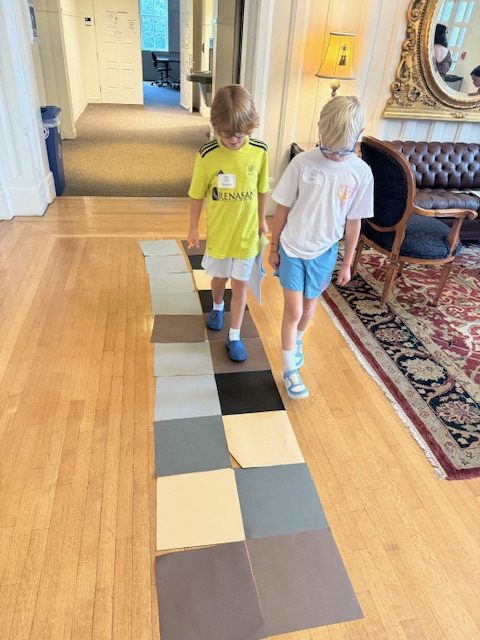Summer SAVY, Session 5 Day 3, “Encounters with Measurement” (1st-2nd)
Dear SAVY Families,
Hello! We had another day filled with learning and discovery at SAVY Summer 2025 Session Five: Encounters with Measurement. The mathematicians once again exceeded expectations today, and I am eager to share the news with you!
We started the day reviewing linear measurement (length, perimeter, and area). We discussed that linear measurement takes place in two dimensions, and that we use units and square units to measure objects with two dimensions. To wrap up our learning on linear measurement, we reviewed the concept of area. Using 12in x 12in, or 1 square foot, of scrapbook paper, students were challenged to model all the ways they could create a 20-square-foot array. This led to a discussion about how we could be sure that we had all the possible arrays for a 20 square foot area. I was impressed with the young mathematicians’ understanding of area and using multiplication to find area! To finish our discovery of area, mathematicians used their knowledge to predict what would happen to an area measurement if you doubled, tripled, or quadrupled one or both dimensions of a plane figure. We started simple, using a 2-foot x 3-foot array, and worked with larger arrays after that. In connection with the Yeti, we learned that humans need 20 square feet each in the classroom space. If the Yeti is double our size, and needs double the space we need, can the Yeti fit at school? Ask your mathematician this tonight! After two days, I am sure mathematicians have a great grasp on the concept of area!
We spent the afternoon learning about measuring liquid volume and capacity, which is a measurement that takes place in three dimensions. We started by learning some terms that were once common in measurement that are no longer used. For example, did you know that 1 jigger is equal to 2 mouthfuls, and that 2 jiggers are equal to 1 jack? These terms, while silly, also presented us with the terms we still use today to measure liquid volume, such as cups, quarts, pints, and gallons. Mathematicians were taught about conversion and why it is necessary to convert units to have an accurate measurement. We heard a story about “King Gallon.” This story helped us to better visualize the conversion of standard liquid measurements. Your mathematician should be able to tell you this story! To end our class, mathematicians estimated the volume of different containers before discovering the true volume and finding the difference between the estimated volume and the real volume. Volume is definitely the most challenging concept of measurement that we will cover in our class, so we will pick up with this concept in the morning!
The SAVY Mathematicians have taken a keen interest in cryptid creatures other than just the Yeti. Each day in the closing circle, we review the concepts from the day, and we read a chapter of the cryptid creature field guide. The SAVY mathematicians specifically requested that a link to this book be sent home, as many would like to continue learning about as many cryptids as they can.
Questions to ask your SAVY Mathematician tonight:
- How did you know you had found all of the arrays for a 20 square foot area?
- What is volume? What is capacity?
- Capacity is not only used for measuring liquid. What else is capacity used for?
- What units do you use to measure liquid volume?
- Why is conversion important? How do you convert units?
I hope you have a relaxing evening, and I look forward to developing more mathematical knowledge with the SAVY Mathematicians tomorrow!
Sincerely,
Ms. Gruchot


